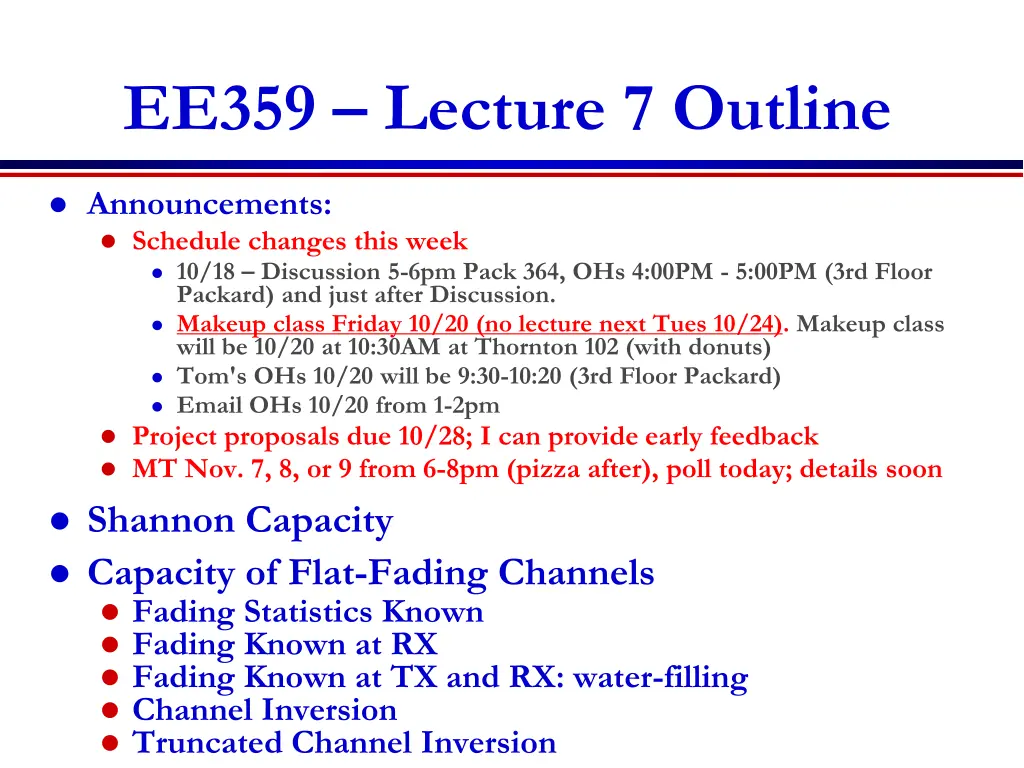
Understanding Capacity in Wireless Fading Channels
Explore the concepts of Shannon capacity and capacity in flat-fading channels, discussing fading statistics and the impact of transmitter and receiver knowledge. Learn how fading affects channel capacity and strategies for optimal data rate utilization in wireless communication systems.
Uploaded on | 2 Views
Download Presentation

Please find below an Image/Link to download the presentation.
The content on the website is provided AS IS for your information and personal use only. It may not be sold, licensed, or shared on other websites without obtaining consent from the author. If you encounter any issues during the download, it is possible that the publisher has removed the file from their server.
You are allowed to download the files provided on this website for personal or commercial use, subject to the condition that they are used lawfully. All files are the property of their respective owners.
The content on the website is provided AS IS for your information and personal use only. It may not be sold, licensed, or shared on other websites without obtaining consent from the author.
E N D
Presentation Transcript
EE359 Lecture 7 Outline Announcements: Schedule changes this week 10/18 Discussion 5-6pm Pack 364, OHs 4:00PM - 5:00PM (3rd Floor Packard) and just after Discussion. Makeup class Friday 10/20 (no lecture next Tues 10/24). Makeup class will be 10/20 at 10:30AM at Thornton 102 (with donuts) Tom's OHs 10/20 will be 9:30-10:20 (3rd Floor Packard) Email OHs 10/20 from 1-2pm Project proposals due 10/28; I can provide early feedback MT Nov. 7, 8, or 9 from 6-8pm (pizza after), poll today; details soon Shannon Capacity Capacity of Flat-Fading Channels Fading Statistics Known Fading Known at RX Fading Known at TX and RX: water-filling Channel Inversion Truncated Channel Inversion
Review of Last Lecture Wideband channels: Bu>>1/ Tm Scattering Function: Used to characterize c( ,t) statistically s( , )=F F t[Ac( , t)] Multipath Intensity Profile: Determines average ( Tm) and rms ( Tm) delay spread Coherence bandwidth Bc=1/ Tm B m / 1 B B u c T u Ac(f) 1 f 2 0 Bc
Review Continued Scattering Function: s( , )=F F t[Ac( , t)] Doppler Power Spectrum: Sc( )= F F t[Ac( f=0, t) Ac( t)] Ac( f, t)=F F [Ac( , t)] Sc( ) Power of multipath at given Doppler Doppler spread Bd: Max. doppler for which Sc ( )>0. Coherence time Tc=1/Bd: Max time over which Ac( t)>0 Ac( t)=0 implies signals separated in time by t uncorrelated at RX Why do we look at Doppler w.r.t. Ac( f=0, t)? Captures Doppler associated with a narrowband signal Autocorrelation over a narrow range of frequencies Fully captures time-variations, multipath angles of arrival Bd
Shannon Capacity Defined as channel s maximum mutual information Shannon proved that capacity is the maximum error-free data rate a channel can support. Theoretical limit (not achievable) Channel characteristic Not dependent on design techniques bps = B + In AWGN, B is the signal bandwidth =Pr/(N0B) is the received signal to noise power ratio log2 1 ( ) C
Capacity of Flat-Fading Channels Capacity defines theoretical rate limit Maximum error free rate a channel can support Depends on what is known about channel Fading Statistics Known Hard to find capacity Fading Known at Receiver Only ( 1 log 0 ) = + + ( ) log 1 ( 2 ) C B p d B 2 Fading known at TX and RX Multiplex optimal strategy over each channel state
Capacity with Fading Known at Transmitter and Receiver For fixed transmit power, same as with only receiver knowledge of fading Transmit power P( ) can also be adapted Leads to optimization problem max ( + ) P = ( log 1 ) C B p d 2 ( ( = : ) [ )] P E P P P 0
Optimal Adaptive Scheme Waterfilling Power Adaptation 1 0 0 ( P ) P 1 1 = 0 0 1 else 0 Capacity R = log ( ) . p d 2 B 0 0
Channel Inversion Fading inverted to maintain constant SNR Simplifies design (fixed rate) Greatly reduces capacity Capacity is zero in Rayleigh fading Truncated inversion Invert channel above cutoff fade depth Constant SNR (fixed rate) above cutoff Cutoff greatly increases capacity Close to optimal
Capacity in Flat-Fading Rayleigh Log-Normal
Main Points Fundamental channel capacity defines maximum data rate that can be supported on a channel Capacity in fading depends what is known at TX/RX Capacity with RX CSI is average of AWGN capacity Capacity with TX/RX knowledge requires optimal adaptation based on current channel state Almost same capacity as with RX knowledge only Channel inversion has poor performance, but significantly improved with truncation
